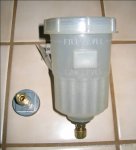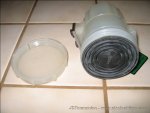m-35tom said:
.... exception is m/c that has bellows, allows fluid to go down usually only applies to disk systems
True, but not in the context of my answer. Disc brakes essentially cycle almost no fluid during a braking cycle. There are usually no retraction springs in a disc brake system, the pads are basically in contact with the rotor at all times. When a disc brake is applied, there is very little fluid displaced. However, the fluid pressure in the caliper increases, causing the pads to grip the rotor more firmly to provide braking action, but with a minimal amount of brake fluid displacement. However, as the brake pads wear over time, enough fluid is displaced to force the caliper brake piston out to compensate for the amount of pad wear.
When the disc pads are replaced, the pistons are retracted to their original position and the fluid displaced to compensate for brake pad wear is returned to the master cylinder reservoir. Thus, a disc brake system cycles brake fluid once per life cycle of the brake pads, vs one complete fluid displacement cycle per brake apply/release cycle on a drum brake system. See my remarks on drum brakes below. Also note that most common brake systems are disc front and drum rear, so the fluid displacement concern only applies to the drum portion of combined systems, and the entire brake system of full drum brake systems as on the Deuce.
m-35tom said:
..... drum brakes have a relative constant level in m/c.
Only in a static condition, i.e. brakes not applied, as when you are checking the master cylinder fluid level. Drum brakes displace fluid every time the brakes are applied and released, thus the drum brake reservoir on a combined disc/drum brake system, and the entire reservoir on an all drum system is constantly "breathing". Every time a drum brake system is applied, the brake master cylinder displaces enough brake fluid to extend the pistons in the wheel cylinders to effect a braking action (2 wheel cylinders in a typical disc/drum passenger car system, 6 large wheel cylinders in a typical 3 axle Deuce). The M/C breather vent allows enough air into the M/C reservoir to replace the fluid displaced and then exhausts the air as the brakes are released and the fluid is returned to the reservoir by the action of the return springs on the brake shoes.
This "breathe in and out" cycle repeats every time the brakes are cycled. While the volume of air is not all that great, only a cubic inch or so per cycle, it is repeated over and over again every time the brakes are applied and released. Since the Deuce M/C cap does not have a rubber diaphragm to isolate the brake fluid from the air in the reservoir, the brake fluid is in constant contact with any moisture in the outside air as the brakes are cycled. If DOT 3 fluid is being used, it will eventually absorb enough water to cause problems unless the DOT 3 fluid is periodically flushed and replaced. DOT 5 fluid (NOT DOT 5+ or DOT 5.1) will not absorb water and is less likely to have a contamination problem.



